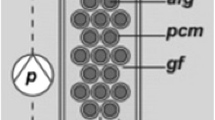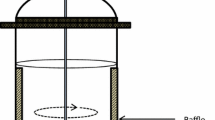Abstract
Four strains of marine microalgae commonly used as live feeds in hatcheries (Isochrysis sp. T.ISO, Tetraselmis suecica, Phaeodactylum tricornutum, Nannochloropsis sp.) were grown in a novel solid-state photobioreactor, the twin-layer system. Microalgae were immobilized by self adhesion to vertically oriented twin-layer modules which consisted of two different types of ultrathin layers, a macroporous source layer (glass fiber nonwoven) through which the culture medium was transported by gravity flow, and a microporous substrate layer (plain printing paper) which carried the algae on both surfaces of the source layer. This simple open cultivation system effectively separated the immobilized microalgae from the bulk of the growth medium and permitted prolonged cultivation of microalgae with average biomass yields of 10–15 g dry weight m−2 growth area after 14–25 days of cultivation. Algal biomass was harvested as fresh weight (with 72–84 % water content) without the need to pre-concentrate algae. No aeration or external CO2 supply was necessary, and due to the microporous substrate layer, no eukaryotic contaminations were observed during the experiment. All experiments were conducted in Germany under greenhouse conditions with natural sunlight. Small-scale growth experiments performed under the same conditions revealed that growth over most of the experimental period (24 days) was linear in all tested algae with growth rates (dry weight per square meter growth area) determined to be 0.6 g m−2 day−1 (Isochrysis), 0.8 g m−2 day−1 (Nannochloropsis), 1.5 g m−2 day−1 (Tetraselmis), and 1.8 g m−2 day−1 (Phaeodactylum). Due to its cost-effective construction and with further optimisation of design and productivity at technical scales, the twin-layer system may provide an attractive alternative to methods traditionally used to cultivate live microalgae.




Similar content being viewed by others
References
Aji LP (2011) The use of algae concentrates, dried algae and algal substitutes to feed bivalves. Makara, Sains 15:1–8
Benemann JR, Tillett DM, Weissman JC (1987) Microalgae biotechnology. Trends Biotechnol 5:47–53
Borowitzka MA (1997) Microalgae for aquaculture: opportunities and constraints. J Appl Phycol 9:393–401
Brown MR, Jeffrey SW, Volkman JK, Dunstan GA (1997) Nutritional properties of microalgae for mariculture. Aquaculture 151:315–331
Camacho FG, Gomez AC, Sobczuk TM, Grima EM (2000) Effects of mechanical and hydrodynamic stress in agitated, sparged cultures of Porphyridium cruentum. Process Biochem 35:1045–1050
Carvalho AP, Meireles LA, Malcata XF (2006) Microalgal reactors: a review of enclosed sysem designs and performances. Biotechnol Progr 22:1490–1506
Christensen L, Sims R (2011) Production and harvesting of microalgae for wastewater treatment, biofuels and bioproducts. Biotechnol Adv 29:686–702
Coutteau P, Sorgeloos P (1992) The use of algal substitutes and the requirements for live algae in the hatchery and nursery rearing of bivalve molluscs: an international survey. J Shellfish Res 11:467–476
de-Bashan LE, Bashan Y (2010) Immobilized microalgae for removing pollutants: review of practical aspects. Bioresource Technol 101:1611–1627
Gudin C, Chaumont D (1991) Cell fragility—the key problem of microalgae mass-production in closed photobioreactors. Bioresource Technol 38:145–151
Hemaiswarya S, Raja R, Ravi Kumar R, Ganesan V, Anbazhagan C (2011) Microalgae: a sustainable feed source for aquaculture. World J Microbiol Biotechnol 27:1737–1746
Jacobsen A, Grahl-Nielsen O, Magnesen T (2010) Does a large-scale continuous algal production system provide a stable supply of fatty acids to bivalve hatcheries? J Appl Phycol 22:769–777
Lau PS, Tam NFY, Wong YS (1998) Operational optimization of batchwise nutrient removal from wastewater by carrageenan immobilized Chlorella vulgaris. Water Sci Technol 38:185–192
Léonard A, Dandoy P, Danloy E, Leroux G, Meunier CF, Rooke JC, Su B-L (2011) Whole-cell based hybrid materials for green energy production, environmental remediation and smart cell-therapy. Chem Soc Rev 40:860–885
Loubière K, Olivo E, Bougaran G, Pruvost J, Robert R, Legrand J (2009) A new photobioreactor for continuous microalgal production in hatcheries based on external-loop airlift and swirling flow. Biotechnol Bioeng 102:132–147
Marchetti J, Bougaran G, Le Dean L, Mégrier C, Lukomska E, Kaas R, Olivo E, Baron R, Robert R, Cadoret JP (2012) Optimizing conditions for the continuous culture of Isochrysis aff. galbana relevant to commerical hatcheries. Aquaculture 326–329:106–115
Marshall R, McKinley S, Pearce CM (2010) Effects of nutrition on larval growth and survival in bivalves. Rev Aquacult 2:33–55
Moreno-Garrido I (2008) Microalgae immobilization: current techniques and uses. Bioresource Technol 99:3949–3964
Muller-Feuga A (2000) The role of microalgae in aquaculture: situation and trends. J Appl Phycol 12:527–534
Nowack ECM, Podola B, Melkonian M (2005) The 96-well twin-layer system: a novel approach in the cultivation of microalgae. Protist 156:239–251
Ozkan A, Kinney K, Katz L, Berberoglu H (2012) Reduction of water and energy requirement of algae cultivation using an algae biofilm photobioreactor. Bioresource Technol 114:542–548
Podola B, Melkonian M (2003) A long-term operating algal biosensor for the rapid detection of volatile toxic compounds. J Appl Phycol 15:415–424
Provasoli L (1963) Growing marine seaweeds. In: DeVirville D, Feldmann J (eds) Proceedings of the fourth international seaweed symposium, vol 4. Pergamon Press, Oxford, pp 9–17
Rivero-Rodriguez S, Beaumont AR, Lora-Vilchis MC (2007) The effect of microalgal diets on growth, biochemical composition, and fatty acid profile of Crassostrea corteziensis (Hertlein) juveniles. Aquaculture 263:199–210
Schenk PM, Thomas-Hall SR, Stephens E, Marx UC, Mussgnug JH, Posten C, Kruse O, Hankamer B (2008) Second generation biofuels: high-efficiency microalgae for biodiesel production. Bioenerg Res 1:20–43
Shi J, Podola B, Melkonian M (2007) Removal of nitrogen and phosphorus from wastewater using microalgae immobilized on twin layers: an experimental study. J Appl Phycol 19:417–423
Sierra E, Acien FG, Fernandez JM, Garcia JL, Gonzalez C, Molina Grima E (2008) Characterization of a flat plate photobioreactor for the production of microalgae. Chem Eng J 138:136–147
Sturm BSMM, Lamer SL (2011) An energy evaluation of coupling nutrient removal from wastewater with algal biomass production. Appl Energ 88:3499–3506
Tredici MR (2004) Mass production of microalgae: Photobioreactors. In: Richmond A (ed) Handbook of microalgal culture: biotechnology and applied phycology. Blackwell Publ, Iowa, USA, pp 178–214
Uduman N, Qi Y, Danquah MK, Forde GM, Hoadley A (2010) Dewatering of microalgal cultures: a major bottleneck to algae-based fuels. J Renew Sustain Energy 2:012701
Walne PR (1970) Studies on the food value of nineteen genera of algae to juvenile bivalves of the genera Ostrea, Crassostrea, Mercenaria, and Mytilus. Fishery Investigations Series II, Volume 26, Number 5. London: Ministry of Agriculture, Fisheries and Food. 62p
Zmora O, Richmond A (2004) Microalgae production for aquaculture. In: Richmond A (ed) Handbook of microalgal culture: biotechnology and applied phycology. Blackwell Publ, Iowa, USA, pp 365–379
Acknowledgments
The development of the twin-layer PBR was supported by Algenion GmbH & Co. KG (Dietzenbach, Germany), which the authors gratefully acknowledge. Furthermore, we would like to thank Leo Leson and the staff of the workshop of the Cologne Biocenter, University of Cologne for their excellent technical support during development and construction of the twin-layer PBRs.
Author information
Authors and Affiliations
Corresponding author
Rights and permissions
About this article
Cite this article
Naumann, T., Çebi, Z., Podola, B. et al. Growing microalgae as aquaculture feeds on twin-layers: a novel solid-state photobioreactor. J Appl Phycol 25, 1413–1420 (2013). https://doi.org/10.1007/s10811-012-9962-6
Received:
Revised:
Accepted:
Published:
Issue Date:
DOI: https://doi.org/10.1007/s10811-012-9962-6




